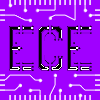This article contains the terms that we will often encounter in the succeeding lessons in Electronics.
AC and DC
Electricity flows in two ways, either in alternating current (AC) or in direct current (DC). The difference between AC and DC has to do with the direction in which the electrons flow.
In DC, the electrons flow steadily in a single direction, or "forward." In AC, electrons keep switching directions, sometimes going "forwards" and then going "backwards." DC is the kind of electricity generated by a battery. On the other hand, the power that comes from wall outlets is AC.
AC can even be changed to DC by an adapter, such as that used to power the battery on a laptop.
Source: Wise Geek
Rectification
Rectification is the process of converting AC to DC. A device which performs the opposite function (converting DC to AC) is known as an inverter.
The simplest kind of rectifier circuit is the half-wave rectifier. It only allows one half of an AC waveform to pass through to the load.
Other types of rectifiers include center-tapped full-wave and full-wave bridge rectifier. More of rectification will be discussed in Diode Applications.
Source: All About Circuits
Diodes
There are a number of different electronic devices which tend to be called diodes. Diodes have the following characteristics:
*Diodes are two terminal devices like resistors and capacitors. They don't have many terminals like transistors or integrated circuits.
*In diodes current is directly related to voltage, like in a resistor. They're not like capacitors where current is related to the time derivative of voltage or inductors where the derivative of current is related to voltage.
*In diodes the current is not linearly related to voltage, like in a resistor.
*Diodes only consume power. They don't produce power like a battery. They are said to be passive devices.
*Diodes are nonlinear, two terminal, passive electrical devices.
In general, diodes tend to permit current flow in one direction, but tend to inhibit current flow in the opposite direction.
Source: Bucknell.edu
Semiconductors
A semiconductor is a material that has an electrical conductivity due to flowing electrons (as opposed to ionic conductivity) which is intermediate in magnitude between that of a conductor and an insulator.
Source: Wikipedia
Doping
In semiconductor production, doping is the process of intentionally introducing impurities into an extremely pure (also referred to as intrinsic) semiconductor to change its electrical properties. The impurities are dependent upon the type of semiconductor.
Elements such as Silicon and Germanium are very common dopant materials.
Source: Wikipedia
P-N Junction
A p–n junction is formed by joining positive-type and negative-type semiconductors together in very close contact. The p-type and n-type are obtained by carrying out the process of doping. The term junction refers to the boundary interface where the two regions of the semiconductor meet.
P-N junctions are elementary "building blocks" of almost all semiconductor electronic devices such as diodes, transistors, solar cells, LEDs, and integrated circuits; they are the active sites where the electronic action of the device takes place. For example, a common type of transistor, the bipolar junction transistor, consists of two p–n junctions in series, in the form n–p–n or p–n–p.
Source: Wikipedia
Biasing
Biasing is process of applying potential across any electronic equipment in order to make it operate correctly.
If, for example, a battery is used to supply bias to a PN junction and is connected so that its voltage opposes the junction field, it will reduce the junction barrier and, therefore, aid current flow through the junction. This type of bias is known as forward bias, and it causes the junction to offer only minimum resistance to the flow of current.
On the other hand, if the battery mentioned earlier is connected across the junction so that its voltage aids the junction, it will increase the junction barrier and thereby offer a high resistance to the current flow through the junction. This type of bias is known as reverse bias.
Source: TPUB
It is important to remember and understand these terms because we will be using it on further discussions.
Tuesday, July 27, 2010
Subscribe to:
Post Comments (Atom)











0 people rectified:
Post a Comment